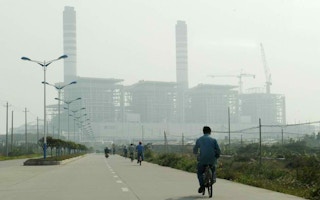Guangdong, China’s most populous province with more than 100 million people, is to launch a carbon permits market next month that will be the world’s second biggest after the European Union.
China, the world’s biggest emitter of greenhouse gases, has pledged to reduce its carbon dioxide emissions per unit of GDP by up to 45 percent by 2020. Shanghai launched a carbon market on Tuesday and Beijing follows on Thursday.
The scheme in heavily industrialized Guangdong will cap carbon dioxide emissions from 202 companies at 350 million tons for 2013, according to a statement on the website of the provincial Development and Reform Commission.
Most permits, including 97 percent of what emitters get, will be handed out free on December 10, but the local government will also auction 29 million permits for this year from mid-December, it said, without giving a specific date.
The Guangzhou-based China Emissions Exchange will then launch a secondary market for permits by the end of December.
Among the firms covered by the scheme, which will dwarf the markets in Australia and California, are state-owned power companies Datang, Huaneng and Shenhua, along with manufacturers and petrochemical firms.
Opening bids for the auctioned permits should be made at 60 yuan ($9.85), the government said, but the Guangdong emissions trading scheme does not have a formal floor price.
Carbon permits on the Shenzhen market, China’s first, ended at 72.76 yuan on Tuesday while those in Shanghai made their debut the same day at 27 yuan.
Beijing’s market will be around a quarter the size of the Guangdong scheme in terms of CO2 covered.
Further markets are due to open in Hubei province and the cities of Chongqing and Tianjin in 2014.
The permits auctioned in Guangdong will include 10.5 million for the quotas of the 202 emitters. The rest are from a reserve of 38 million permits set aside to cover new entrants and various “adjustments”, the local government document said, without offering further detail.
Guangdong will keep the level of auctioned permits at 3 percent of quotas next year but from 2015 some 10 percent will be sold.
In total, the seven pilot markets in China will regulate around 700-800 million tons of carbon dioxide annually, roughly equal to the annual emissions of Germany, and will cover areas accounting for nearly a third of China’s gross domestic product.
The regional markets are meant to generate valuable experience as central government is planning a national trading scheme later in the decade.










